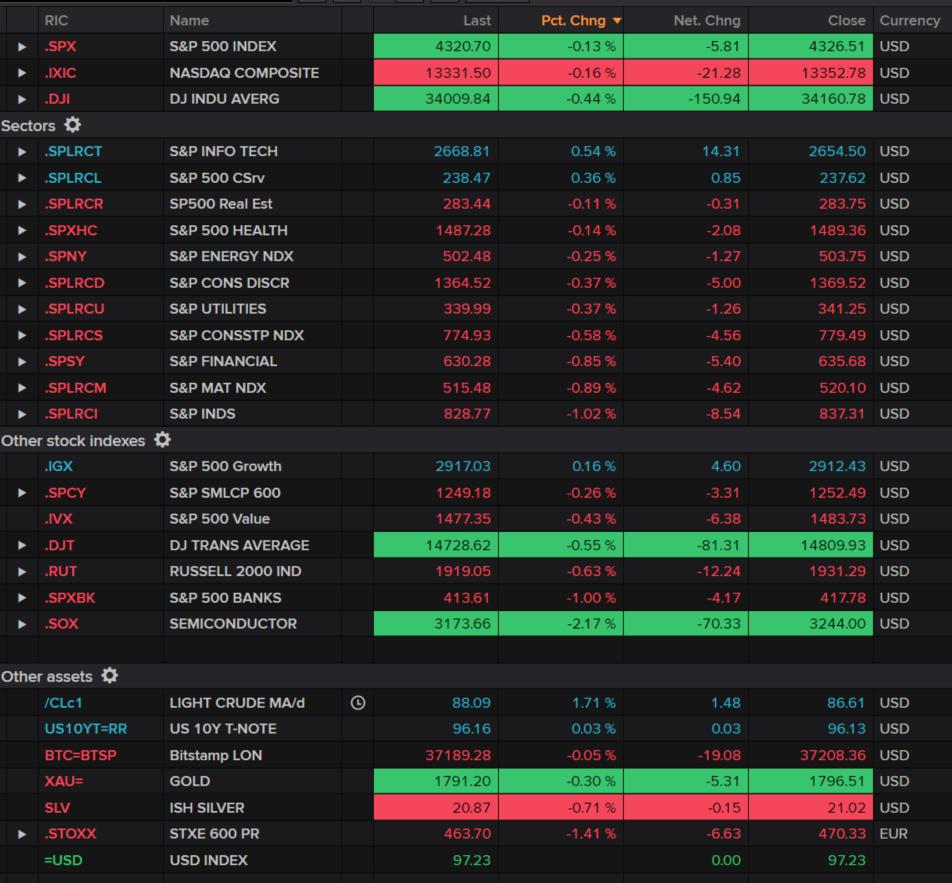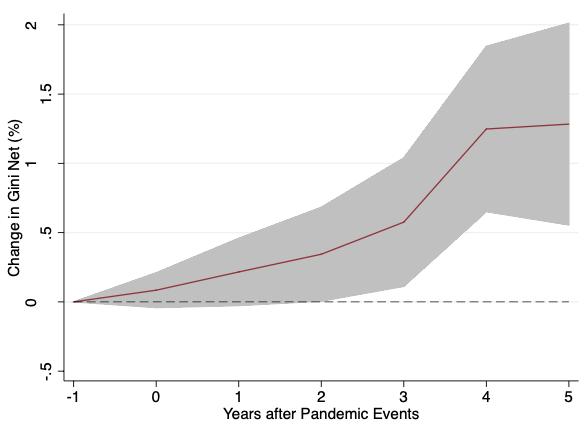Jan 28 - Welcome to the home for real-time coverage of markets brought to you by Reuters reporters. You can share your thoughts with us at markets.research@thomsonreuters.com
WALL STREET CLOSES MESSY WEEK WITH TECH-LED RALLY (1605 EST/2105 GMT)
Wall Street's three major averages rallied sharply on Friday, ending a volatile week with another choppy session as investors kept watch on earnings reports and interest rate hike expectations, and Russia/Ukraine tensions which have put countries around the world on the alert.
Register now for FREE unlimited access to Reuters.com
After opening higher on Friday, the S&P 500 (.SPX) quickly dipped into the red before turning positive again at 1050 AM EST and staying above water for the rest of the session with a few threats toward the downside.
For the week, unofficially, the SPX closed up 0.8% while Nasdaq (.IXIC) gained 0.01% and the Dow (.DJI) added 1.4%
However, at the end of its second to last trading day of the month, the S&P 500 was on track for its weakest January since 2009, while the Nasdaq was on course for its biggest January decline ever.
In sectors, technology was the biggest gainer on the day, closing up 4.3%, for its biggest percentage gain since April 6 2020, while energy was the weakest group finishing down 0.6%.
"What we've been seeing for two weeks now is individual investors buying in the morning and institutional selling in the afternoon this is the reversal ... it looks like institutional selling may have abated," said John Augustine, chief investment officer at Huntington National Bank.
"We broke a technical level and now we're coming back up to it supported by earnings and less than expected wage inflation and now we're coming back, led by the tech sector in a big way."
Among earnings reports that impressed was one from Apple Inc (AAPL.O). The stock closed up almost 7%.read more
While the S&P 500 finished just below its 200-day moving average on Friday, the technology sector closed above that hurdle for the first time since January 20.
Here is your closing snapshot:
(Sinéad Carew)
*****
IN A WOBBLY MARKET, ARK ETF SHORT SELLERS ARE DOING WELL (1353 EST/1853 GMT)
Short selling in Cathie Wood's ARK family of exchange trade funds (ETFs) has made a u-turn recently according to S3 Partners, which says that the short selling it saw in 2021 has turned into short covering in 2022.
In the last 30 days the analytics firm said it saw $676 million worth of buy-to-covers in aggregate, and $490 million of covering in its most shorted ETF, the ARK Innovation ETF (ARKK.P).
And S3 notes that short interest in the ARK family of funds has dipped below the $3 billion mark for the first time since mid-2021. While the ETF's short interest as a percentage of float is smaller than the average U.S. ETF, their stock borrow fees are higher as availability is limited.
While shorting ARK funds outperformed the market in 2021, short sellers have topped their 2021 returns in less than one month in 2022, according to S3.
While shorts were up $941 million or 28.81% in 2021, less than one month in 2022, they are already up $999 million, or 30.11%, S3 writes.
(Sinéad Carew)
*****
INDIVIDUAL INVESTORS REACT TO NASDAQ'S CORRECTION (1328 EST/1828 GMT)
As part of the most recent American Association of Individual Investors (AAII) Sentiment Surveyread more , AAII asked its members about their feelings on the Nasdaq composite’s drop over the past several weeks. As of Thursday's close, the Nasdaq (.IXIC) was down nearly 17% from its Nov. 19 record finish.
AAII reported that 27% of respondents said that they view the correction in a neutral manner and expected one to occur while about 24% of respondents have a bearish outlook on the correction.
Against this, 21% of respondents view the correction as "a buying opportunity and see the Nasdaq’s drop in a bullish sense."
Meanwhile, 13% of respondents attribute the correction to macroeconomic factors like Federal Reserve policy, rising interest rates and inflation. Around 6% of respondents characterized the correction as "overdone and wasn’t as drastic as many thought."
Here are a couple of quotes from investors on the matter:

“Instead of addressing the inflation previously in a gradual manner, the Fed has backed themselves (and us) into having to more aggressively address it now. And this will slow down the stock market in 2022,” said one respondent.
Another said: “Necessary correction, as in all corrections, overdone on some stocks. Opportunities.”
(Terence Gabriel)
*****
FOUR WITHOUT A BEAR? (1245 EST/1745 GMT)
After the Federal Reserve policy statement was released on Wednesday, it set the tone for an intense round of "how many interest rate hikes?" in the Wall Street 2022 forecasting competition. For some, the answer was "as many as seven."read more
But Allison Nathan, senior strategist in Goldman Sachs global macro research department explained why she still expects just 4 hikes for this year.
Nathan's reasoning is that while the Fed is likely to be looking at a "hot inflation dashboard" at its next few meetings, "the interplay of Fed policy, financial conditions, and the growth outlook could make it hard for the Fed to deliver consecutive hikes."
And the FOMC is still discussing details of the balance sheet runoff process, and Powell's comments, so Nathan expects the announcement of the start of runoff in July.
But while the market has been volatile since the Wednesday Fed statement and continues to digest it all, Nathan believes "the recent equity drawdown will prove to be a correction in a longer bull market cycle, rather than the start of a new bear market" as she sees remaining downside risk as limited "so long as economies continue to grow."
The strategist notes that "the crucial determinant for returns will be what happens to growth as rates begin to rise" as equities digest Fed tightening much better in an environment of rising growth. And she actually expects "a modest improvement in activity in 2Q and 3Q even if rates are starting to rise."
If rates peak at around 2.75%, or around 100bps above market pricing, Nathan notes that "this would still be very low relative to history and unlikely to generate a recession."
And without a recession "equities are likely to make progress this year," the strategist says.
So what should investors do with all this information?
They should see any further significant weakness in indexes as a buying opportunity with more moderate upside given "record low interest rates, high valuations, and high margins," advised the strategist. And she also sees the rotation into value stocks having "further room to run."
Nathan adds, "A near-term catalyst, such as a slowdown in inflation or extremely strong earnings, may be needed before investors re-risk."
(Sinéad Carew)
*****
EUROPE: BAD DAY, BAD WEEK, BAD MONTH (1155 EST/1655 GMT)
What a ride January has been so far!
The year started with the STOXX 600 hitting a new record high which quickly fizzled out just short of a correction last Monday when the pan-European index dropped a whopping 3.8%, its worst session since June 2020.
This was followed by three straight days of gains only to see this session chop off 1% from the European benchmark.
All in all, this month (one final day of trading left on Monday) is set to be the worst since October 2020 with a 4.5% drop. As for this week, it's the poorest performance since last November with a 1.9% fall.
Among the many casualties of the selloff are tech stocks which have tiptoed into bear market territory with a 20% fall since their November highs.
Many other sectors, like Construction & Materials, Industrial Goods & Services and Financial Services have entered a correction with a 10% drop.
There are also other industries such as Chemicals or Autos which seem set to cross that line should sentiment fail to improve in February.
It's a totally different story for banks, insurers, miners and oil majors which have, as expected, thrived as bond yields and inflation rose alongside each other.
Much has been blamed on the Fed's tightening cycle, but geopolitical tensions in Ukraine and some disappointing macro indicators in the euro zone, particularly in Germany, didn't help the market either.
On the bright side, the earnings season has not been a cause for concern so far and expectations for profit growth are still set to just above 50% year-over-year.
This is leaving many sell-side analysts still pretty bullish for European equities and global stock markets for the rest of the year.
"UBS Asset Management’s Multi-Asset team remain of the view that global growth and earnings are likely to remain strong, and that pro-cyclical positions across sectors and regions will perform well over the course of the year", the Swiss bank said in a note published today.
(Julien Ponthus)
*****
SPENDING, INFLATION, INCOME, SENTIMENT: CONSUMERS SING THE BLUES (1106 EST/1606 GMT)
Friday's data joined in unison to sing a song in a minor key about the consumer, who contributes about 70% to the U.S. economy.
U.S. consumers tightened their purse strings in December even as income edged higher, according to the Commerce Department's Personal Consumption Expenditures (PCE) report.read more
Adjusted consumption (USGPCS=ECI) dropped 0.6%, inline with consensus, and a reversal of November's downwardly revised 0.4% growth.
"Spending was hit hard by a combination of the Omicron hit to discretionary services and people’s willingness to visit malls, alongside a void left by earlier-than-usual holiday shopping," writes Ian Shepherdson, chief economist at Pantheon Macroeconomics.
Personal income (USGPY=ECI) grew by 0.3%, and while a cooler number that analysts expected, it stands on the shoulders of the previous month's upwardly revised 0.5% increase.
As a result, the saving rate - the difference between disposable income and outlays - grew to 7.9%.
The saving rate is viewed by many as a gauge of consumer sentiment, about which the University of Michigan has a few things to say, further down.
But first, the more closely watched element of the PCE report - the price index (USPCE=ECI) - showed a slightly cooler than expected monthly gain of 0.4%, a welcome deceleration from the prior month's 0.6% increase.
But year-over-year growth of Core PCE (USPCE2=ECI) - which strips out volatile food and energy prices, and is the Fed's preferred inflation yardstick - came in 10 basis points higher than anticipated at 4.9%, hotter than November's 4.7% print.
Powell & Co have made it clear, particularly this week, that they intend to take off their gloves and combat stubbornly persistent inflation by hiking key interest rates more aggressively than many market participants expected.
Fed funds futures now see five such hikes happening this year, starting in March.
"The latest data support officials' pivot towards addressing high prices by ending asset purchases and initiating rate hikes which will be followed by balance sheet normalization," writes Rubeela Farooqi, chief U.S. economist at High Frequency Economics.
The graphic below shows Core PCE, along with other major indicators, and how long they've soared well above the central bank's average annual 2% inflation target.
The mood of the consumer grew chillier than originally thought in January, dropping to a decade low according to the University of Michigan's final Consumer Sentiment reading (USUMSF=ECI).
The index came in 1.6 lower than the initial take to 67.2, a steeper drop than expected, as consumer attitudes regarding current conditions and near-term expectations both deteriorated more than economists anticipated.
"Although their primary concern is rising inflation and falling real incomes, consumers may misinterpret the Fed's policy moves to slow the economy as part of the problem rather than part of the solution," writes Richard Curtin, chief economist at UMich. "The danger is that consumers may overreact to these tiny nudges, especially given the uncertainties about the coronavirus and other heightened geopolitical risks."
One-year and five-year inflation expectations held firm at 4.9% and 3.1%, respectively. Of note, UMich one-year expectations and PCE core inflation are in agreement.
Finally, employment costs (USEMPC=ECI) rose by 1% in last year's closing months, 0.2 percentage points shy of consensus, while wages in the fourth quarter increased at a slightly faster 1.1% pace, according to the Labor Department.read more
"With labor participation creeping higher, and measures of excess demand flattening in recent months, it is reasonable to think that wage growth is unlikely to re-accelerate dramatically," says Shepherdson. "In the meantime, this report eases the immediate pressure on the FOMC to act aggressively; the sighs of relief from Fed Towers should be audible on Wall Street."
Wall Street once again ping-ponged between green and red and back again in a continuation of a tumultuous week marked by mixed earnings, Fed worries and rising geopolitical tensions.
At last glance, the S&P (.SPX) and the Nasdaq (.IXIC) are green and the Dow (.DJI) is down. But blink, and they'll change.
(Stephen Culp)
*****
WALL STREET LOSES GROUND AFTER THE OPEN (1012 EST/1512 GMT)
Wall Street's major averages are losing ground on Friday after data showed U.S. consumer spending fell in December, suggesting the economy lost speed amid snarled supply chains and raging COVID-19 infections, while annual inflation increased at a pace last seen in the early 1980s.read more
Equity futures had gained ground as the data was released indicating some investor relief that inflation, which still high, was inline with expectations. But while the indexes opened up they quickly reversed to turn red shortly after the open.
Also, major banks were adjusting their expectations for Federal Reserve interest rate hikes, expected to kick off in March of this year with Bank of America economists saying Friday that they now expect the Federal Reserve to hike rates by 25 basis points seven times this year to battle inflation.read more
"What the market wants to know now is whether or not Monday's low will hold in the major indices. They want to see earnings are strong enough to offset the future tightening from the Fed," said Adam Sarhan, chief executive of 50 Park Investments.
"The reason we've so much volatility is because we have so much uncertainty. You just don't know what's going to happen with respect to Fed tightening ... Will it tighten too much and send us into a recession or will it be a soft landing."
Here is your morning trade snapshot:
(Sinéad Carew)
*****
BEARISHNESS HITS 9-YEAR HIGH (0900 EST/1400 GMT)
The percentage of individual investors with a bearish outlook for the U.S. stock market hit a 9-year high in the latest American Association of Individual Investors Sentiment Survey (AAII).
AAII reported that bearish sentiment, or expectations that stock prices will fall over the next six months, gained by 6.2 percentage points to 52.9%, holding above its historical average of 30.5% for the 10th-consecutive week. Additionally, this particular reading is the highest since April 11, 2013 (54.5%)and is the 41st highest reading of bearish sentiment in the survey’s history.
Bullish sentiment, or expectations that stock prices will rise over the next six months, rose by 2.2 percentage points to 23.1%, which is still substantially below its historical average of 38.0%. Bullish sentiment levels have now been below the historical average for 10-straight weeks.
Neutral sentiment, or expectations that stock prices will stay essentially unchanged over the next six months, slid by 8.4 percentage points to 23.9%. Neutral sentiment was last lower on September 2, 2021 (23.2%).
With these changes, the bull-bear spread fell to –29.8 from -25.8 last weekread more . This is the most negative the spread has been since April, 2013:
(Terence Gabriel)
*****
FOR FRIDAY'S LIVE MARKETS' POSTS PRIOR TO 0900 EST/1400 GMT - CLICK HERE:read more
Register now for FREE unlimited access to Reuters.com
Our Standards: The Thomson Reuters Trust Principles.




